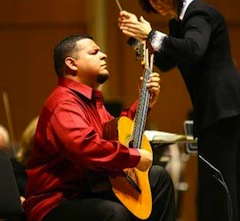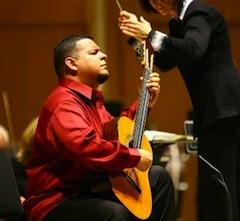
Classical guitarist Isaac Bustos gave an outstanding recital Saturday, presented by the South Bay Guitar Society, at the beautiful Petit Trianon Theatre in San Jose. Born in Nicaragua and educated in the U.S. from age 13, Bustos demonstrated the heartfelt intensity often associated with South American guitarists, in addition to the technical polish and stylistic diversity seen in the best North American–educated artists. The program included dazzling interpretations of Scarlatti, a grand fantasy on opera themes of Rossini written by Giuliani, and Spanish classics by Albéniz and Sainz de la Maza, plus a major new work written for Bustos by the American composer Peter Lieuwen.
The Sonatas of Domenico Scarlatti have long been favored by guitarists. With 555 to choose from, the selections offered display great variety, and Bustos’ chosen set was a delight, performed with passionate intensity and exquisite attention to both the beauty of individual lines and the clarity of contrapuntal design. Bustos presented Sonata K. 377 in B Minor as a joyous Spanish dance, colored Sonata K. 99 in D Minor with harsh, dissonant chords reminiscent of flamenco guitarists, and gave Sonata K. 512 in D Major a virtuosic yet effortless flair.
Bustos’ chosen set [of Scarlatti sonatas] was a delight, performed with passionate intensity.
Isaac Albéniz, one of the more significant figures in Spanish cultural circles at the close of the 19th century, was greatly influenced by Spain’s indigenous music. Bustos performed his Rumores de la caleta with the power of a flamenco malagueña and a subtle impressionistic portrait, evoked by the title, of a remote seaside inlet with softly murmuring waves. Cádiz is a tango habanera in which Bustos combined a playful chordal accompaniment with a tender, folklike melody in the opening and employed mournful flamenco phrasing in a middle section that was inspired by the music of Cadiz’ well-known festival held during Catholic Holy Week. Asturias, named for the province in northeastern Spain, is a portrait of a legendary 8th-century battle with a strikingly dramatic frame and an introspective, middle section. Bustos dazzled with his rhythmic mastery, inexorable in the opening and expressively free in the Arabic middle section.
Bustos turned to a new work, written by Peter Lieuwen, an American composer and a colleague of Bustos at Texas A&M University. Lieuwen has been commissioned, performed, and recorded by orchestras, ensembles, and artists throughout North America and Europe. His wonderful Sonata for Guitar, written for and dedicated to Bustos, is a major work in three movements that features asymmetrical rhythms of world music, impressionistic harmonies, classical development, and exciting virtuosity — all of which Bustos handled with great aplomb. I certainly hope he records this soon.
Bustos was masterful in bringing out the music’s large-scale design and theatricality.
I’m hearing the music of Regino Sainz de la Maza more frequently in recital recently, though I don’t yet understand its appeal. To my ears, it explores the same territory as Albéniz but without the sophistication or depth. Bustos nevertheless played the music masterfully, with a ravishing use of color and wonderful rhythmic control.
It is always possible to change one’s mind about repertoire, however, and on Saturday Bustos taught me to love Mauro Giuliani’s Rossiniane, Op. 119, No. 1. I have always thought it an empty showpiece, yet Bustos was masterful in bringing out the music’s large-scale design and theatricality, making the piece not just a paraphrase of Rossini but rather a miniature opera for solo guitar.
As an encore, the enthusiastic audience was treated to a deeply romantic interpretation of Andante Maestoso, Étude 13 in the Cuartas lecciones para guitarra by Julio Sagreras.

